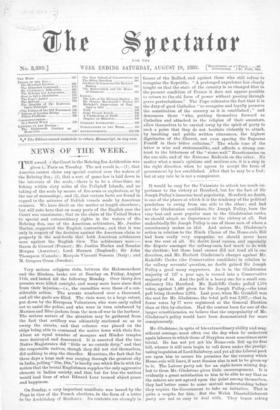Very serious religious riots, between the Mahommedans and the Hindoos,
broke out at Bombay on Friday, August 11th, and lasted till the following Monday. Over thirty-five persons were killed outright, and many more have since died from their injuries,—Ce., the casualties were those of a con- siderable action. The arrests numbered over a thousand, and all the gaols are filled. The riots were, to a large extent, put down by the European Volunteers, who were early called out to assist the police, and who were in tarn reinforced by Marines and'Blue-jackets from the men-of-war in the harbour. The serious nature of the ifituation may be gathered from the fact that artillery was ultimately stationed so as to sweep the streets, and that reliance was placed on the ships being able to command the native town with their fire. About an equal number of mosques and Hindoo temples were destroyed and desecrated. It is asserted that the two Native Magistrates did " little or no outside duty," and that the respectable natives, though they did not riot themselves, did nothing to stop the disorder. Meantime, the fact that for three days a huge mob was surging through the greatest city in India, yelling "Din, Din," is hardly one which fits in with the notion that the brutal Englishman supplies the only aggressive element in Indian society, and that but for him the natives would lead lives of what Edward Lear termed abject peace and happiness.


































